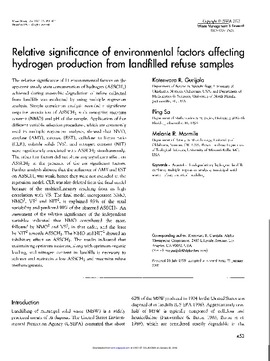| dc.contributor.author | Koteswara R. Gurijala | |
| dc.contributor.author | Ping Sa | |
| dc.contributor.author | Melanie R. Mormile | |
| dc.date.accessioned | 2016-01-14T19:53:12Z | |
| dc.date.accessioned | 2016-03-30T15:32:09Z | |
| dc.date.available | 2016-01-14T19:53:12Z | |
| dc.date.available | 2016-03-30T15:32:09Z | |
| dc.date.issued | 2000-10-01 | |
| dc.identifier.citation | Gurijala, K. R., Ping Sa, & Mormile, M. R. (2000). Relative significance of environmental factors affecting hydrogen production from landfilled refuse samples. Waste Management & Research, 18(5), 453-461. doi: 10.1177/0734242x0001800506 | en_US |
| dc.identifier.uri | https://hdl.handle.net/11244/25118 | |
| dc.description.abstract | The relative significance of 11 environmental factors on the apparent steady-state concentration of hydrogen (ASSCH2) achieved during anaerobic degradation of refuse collected from landfills was evaluated by using multiple regression analysis. Simple correlation analysis revealed a significant negative association of ASSCH2 with newsprint moisture content (NMO) and pH of the sample. Application of five different variable selection procedures, which are commonly used in multiple regression analyses, showed that NMO, amylase (AMY), esterase (EST), cellulose to lignin ratio (CLR), volatile solids (VS), and nitrogen content (NIT) were significantly associated with ASSCH2 simultaneously. The other five factors did not show any significant effect on ASSCH 2 in the presence of the six significant factors. Further analysis showed that the influence of AMY and EST on ASSCH2 was weak, hence they were not included in the regression model. CLR was also deleted from the final model because of the multicollinearity resulting from its high correlation with VS. The final model incorporated NMO, NMO2, VS2 and NIT2; it explained 95% of the total variability and predicted 98% of the observed ASSCH2. An assessment of the relative significance of the independent variables indicated that NMO contributed the most, followed by NMO2 and VS2, in that order, and the least by NIT2 towards ASSCH2. The NMO and NIT 2 showed an inhibitory effect on ASSCH2. The results indicated that maintaining optimum moisture, along with optimum organic loading, and nitrogen content in landfills is necessary to achieve and maintain a low ASSCH2 and maximize refuse methanogenesis. | en_US |
| dc.language.iso | en_US | en_US |
| dc.publisher | Waste Management & Research | |
| dc.subject | Anaerobic biodegradation | en_US |
| dc.subject | hydrogen | en_US |
| dc.subject | landfill | en_US |
| dc.subject | methane | en_US |
| dc.subject | multiple regression analysis | en_US |
| dc.subject | municipal solid waste | en_US |
| dc.subject | refuse | en_US |
| dc.subject | statistical modeling | en_US |
| dc.title | Relative significance of environmental factors affecting hydrogen production from landfilled refuse samples | en_US |
| dc.type | Research Article | en_US |
| dc.description.peerreview | Yes | en_US |
| dc.description.peerreviewnotes | https://us.sagepub.com/en-us/nam/manuscript-submission-guidelines | en_US |
| dc.identifier.doi | 10.1177/0734242x0001800506 | en_US |
| dc.rights.requestable | false | en_US |
